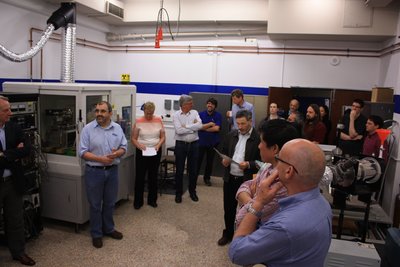Atomic structures and rotating anode sources
Thursday, 20 February, 2014
A new facility at the University of Melbourne’s School of Physics has become home to a rotating anode source. The machine was installed by a team led by Professor Christopher Chantler, who noted that outside synchrotrons (of which there is only one in Australia), rotating anodes are one of the most powerful laboratory sources of X-rays.
Professor Chantler explained that rotating anodes “use good conductors (copper) spinning at high frequencies to prevent the copper block from melting”. This allows much higher power and “means that you can look at structures, science, questions and collect data much faster and more incisively than with other, weaker sources”, he said.
The machine is said to be the safest X-ray source in Australia, with shielding designed and constructed by the School of Physics and the University/Science Workshop. This means students can confidently carry out critical tests in fundamental atomic physics, relativistic quantum theory, X-ray calibrations and detector technology.
Furthermore, the system is apparently capable of probing fundamental and applied X-ray science in more detail than any other fixed laboratory source. According to Professor Chantler, “This super X-ray machine gives us the capability of mapping the energies of the atom previously inaccessible and unseen by other apparatus.”

The research team has already used the device to conduct experiments on copper atoms, which have an unusually difficult structure. The system was said to demonstrate unprecedented accuracy at the atomic level, finding that “earlier standard theory on copper does not yet explain the quantum mechanics which we observe”, said Professor Chantler. Thus, better understanding of the theory is required.
“By understanding this, we can understand new applications and more complex systems too, including environmental toxicity and remediation of other systems,” he said.
Two further experiments are currently being conducted in the lab, both in atomic physics. “Later there will be experiments testing new detector technology,” said Professor Chantler, “and we expect further experiments in such fields as genetics.” Indeed, the machine will be of interest to the chemical, biological and physical sciences, with the X-rays unlocking new information about the electronic properties of materials at the atomic level.
The system has already received interest from Bruker and Berthold, with representatives stating that developments of new technology provide great opportunities for spin-offs and commercial development. In the meantime, though, it will be used to train students in the use of high-brightness sources, opening up opportunities at synchrotrons and free electron lasers.
Professor Chantler is excited not only by the answers which will be provided by the device, but also the questions.
“The ability to question our world in new ways is perhaps one of our fundamental purposes of being here,” he said.
“We should not just be thinking about immediate fast-food rewards in science or technology but about transforming, empowering opportunities.”
Revealed: the complex composition of Sydney's beach blobs
Scientists have made significant progress in understanding the composition of the mysterious...
Sensitive gas measurement with a new spectroscopy technique
'Free-form dual-comb spectroscopy' offers a faster, more flexible and more sensitive way...
The chemistry of Sydney's 'tar balls' explained
The arrival of hundreds of tar balls — dark, spherical, sticky blobs formed from weathered...



